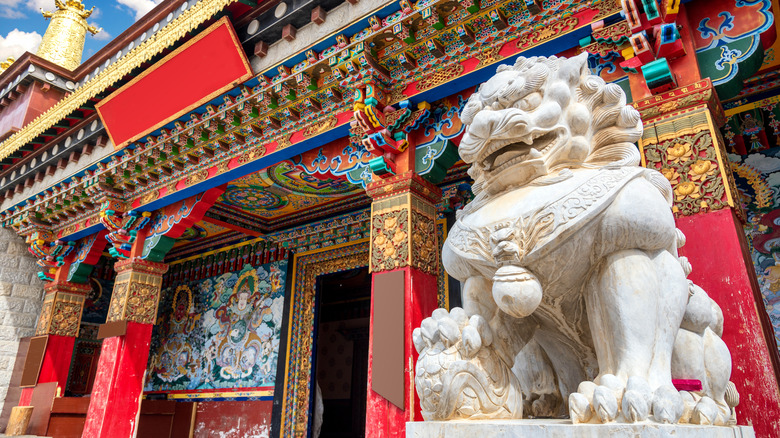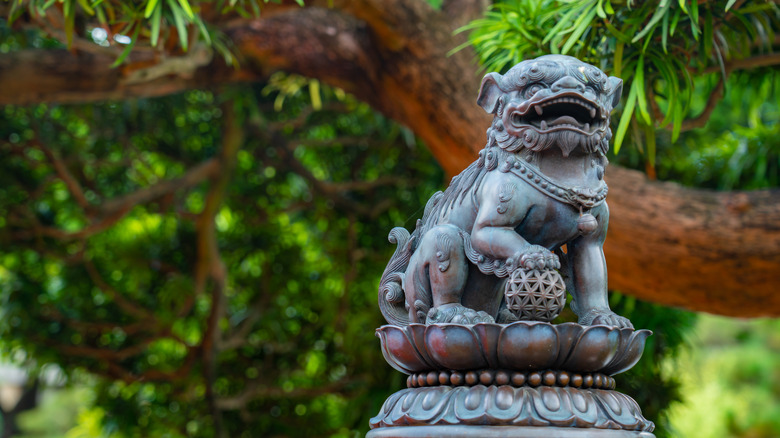What Happened To The Tang Dynasty Marble Lion From Antiques Roadshow?
So you know those little keychain doodabs you can get from cheap souvenir shops that are supposed to convey some sort of cultural authenticity? If you're in Nashville you can probably buy a little guitar keychain as a keepsake. If you're in Paris you can grab a little Eiffel Tower keychain. And if you head to any urban center in China you might be able to find a keychain version of those traditional lion guardian statues — you'd recognize them if you saw them. Now imagine that you've got a big lion statue, it's made from marble, is possibly 1,400 years old, and is worth up to $250,000.
This is exactly what happened in 2002 on the long-running antique appraisal show, "Antiques Roadshow," as we can watch on YouTube. The appraiser of the statue — Lark Mason — made a similar doodab comparison, saying that he'd seen "little tiny versions of these that come in for sale," but never one so large, old, well-crafted, and well-preserved. The craftsman who made the Tang dynasty marble lion must have been a "master," he said. He was so moved by the piece that he nearly started crying.
The seller said that her grandparents traveled a lot in China, and it was there that she bought the statue and passed it along to her mother, who passed it along to her. The Lark Mason Art Advisory says that Mason appraised it at $120,000 to $250,000. We're not sure about the current value, but by 2016 the statue was still worth the same amount.
A 1,100- to 1,400-year-old artifact
To be clear, the marble lion statue from "Antiques Roadshow" is much more than an "antique" dated to the last century. As appraiser Lark Mason said in the original appraisal, pieces like it have all been gobbled up by museums for safekeeping. A millennium-plus-old Tang dynasty statue from China is an artifact of history, not a bauble fit for tossing around a flea market. We can assume that's a big part of the reason why Mason was so overwhelmed during the episode in question — that and the excellent condition of the statue, which while smoothed out in certain places and worn from time, was decidedly pristine.
To brush up on our Chinese history, the Tang dynasty ruled China from 618 to 906 C.E. — around when Charlamagne was uniting some disparate Western European kingdoms. Columbia University describes the Tang era as a time of prosperity, "cosmopolitanism," and "cultural flowering," when Buddhist influences really took hold within Chinese culture. The arts were highly valued at this time, particularly "the three perfections:" painting, poetry, and calligraphy. According to Mason, this was the "golden period of Chinese art."
The Metropolitan Museum of Art says that lions were commonly featured in Chinese statues possibly because they were "exotic" and not indigenous to the Chinese mainland (some might have been kept in Han dynasty imperial parks). Statue styles evolved through different periods, from the Han dynasty (206 B.C.E. to 220 C.E.) all the way to the Ming dynasty (1368 C.E. to 1644 C.E.) and beyond.
Stable value over time
Aside from the cultural and historical value of a 1,100- to 1,400-year-old piece of Chinese art, we've got the monetary value. As the Lark Mason Art Advisory says, the statue could have gone for $120,000 to $180,000 at an auction. If the owner wanted to keep it and take out an insurance policy on it, she should have aimed for $150,000 to $250,000. And indeed, it seems like this is exactly what the owner wanted to do. When Mason quoted to her the auction price, she simply replied, "Not that I'd sell it." And when Mason told her the insurance policy value, she quipped, "So it was worth lugging it in here." So yes, we could guess that the statue was a bit heavy.
At present, we don't know the precise fate of the marble lion statue from the Tang dynasty that was appraised on "Antiques Roadshow" back in 2002. The Lark Mason Art Advisory says that come 2016 the statue was valued at the same range — $120,000 to $250,000 — and that's that. Its value hasn't gone down. Back in the episode, Mason said that the statue was very clearly crafted by a "master" carver, implying that not all such statues are of the same quality. The sandy texture was excellent, as was the patina — the sheen on the surface. The statue spoke its own history, in other words. Thankfully, we can assume it's remained in good hands since its appraisal.

